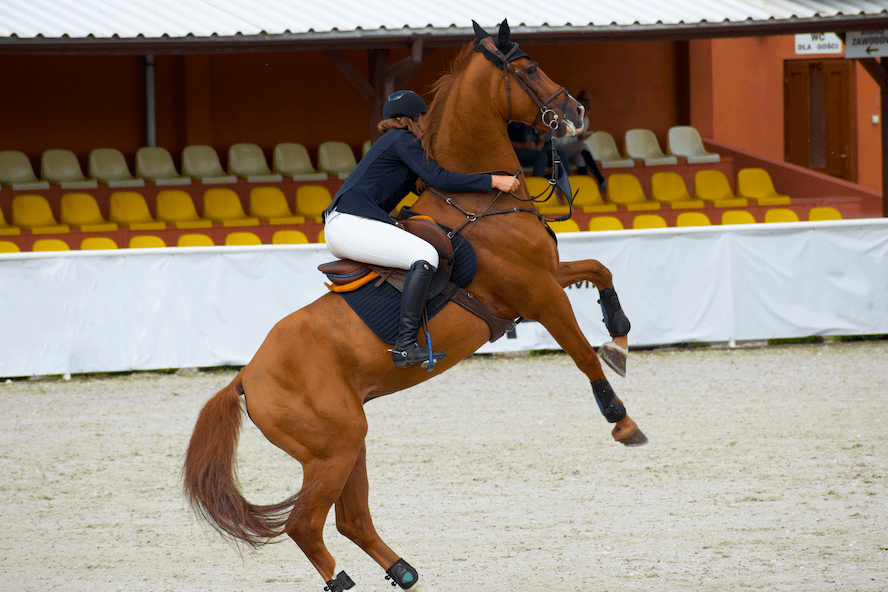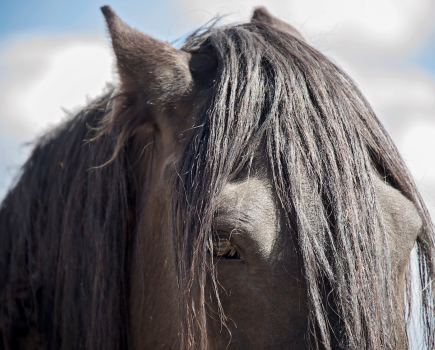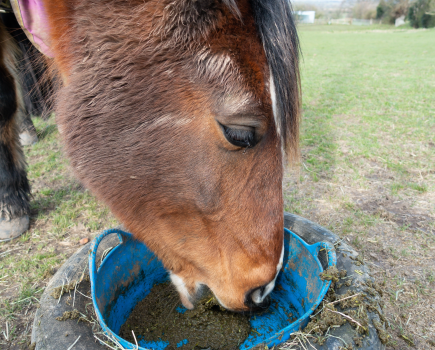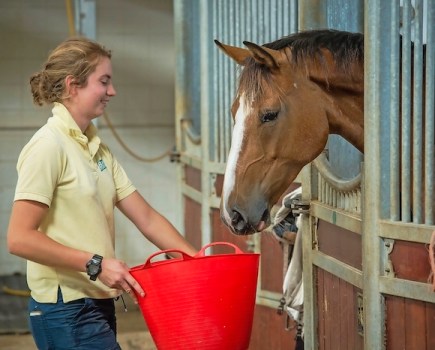A horse rearing up while you are riding is an unpleasant and often frightening experience. It is the sort of behaviour that most riders fear — and with good reason. Should the horse rear high enough that they lose balance and fall over backwards, you as the rider could be seriously injured.
You may be surprised to learn that only 0.01% of horses will fall over when rearing in their natural habitat, such as in the field. It’s when riders get involved that the percentage of horse falls when rearing increases.
Rearing up is a horse behaviour that can be predicted and therefore prevented. If your horse does go up, there are techniques you can follow to stop you sliding off, or your horse going over on top of you.
How to predict rearing
Stunt riders and trainers Karl Greenwood and Zana Cousins-Greenwood teach riders a toolkit of techniques to take away the panic and stress associated with a horse rearing up.
“Some of it is mindset,” explains Zana. “If you know what you’re doing, you won’t fall off, but your brain needs to catch up.”
Karl adds: “Lots of students tell me the thing that scares them the most is how quickly a rear happens, which leaves them unprepared for it.
“Actually, horses do give us signs that they are about to go up, but we have to be looking for them. I’m always tuned in to my horse when I ride. Even on a quiet hack, I’m aware of what’s happening beneath and around me.”
According to the Greenwoods, if a horse is about to rear, you’ll feel them shorten up as if they’re about to spring forward and their ears will twitch.
Bear in mind as well that a horse has to be static in order to rear, so they’ll need to stop first. That might mean a horses is cantering, then they stop and start rearing, for instance. Preventing a horse from stopping, and keeping them going forward, is key to avoiding rearing up.
Why horses rear
It’s essential to understand why your horse is rearing as this will help to eliminate the behaviour. It’s easy to think they’re being badly behaved, but could they be in pain or feeling sore? It’s vital that you rule this out first.
Pain that could cause rearing up could be (and bear in mind that this is not an exhaustive list — there are lots of potential causes to be on the alert for):
- Tooth or dental pain
- Hoof pain
- Kissing spines
- Soreness in the girth area
If your horse is prone to rearing, or suddenly starts doing it, contact your vet and rule out pain as a cause is the first thing you need to do.
Once you have confirmed that pain isn’t the problem, you can move on to considering whether diet and/or training are the underlying causes.
Other reasons a horse may rear include:
- Rider holding on to the reins too tight.
- Horse is in panic mode.
- Rearing up is a natural reaction when a horse is stressed or fearful (a barking dog snapping at their legs, for example).
- Horse is being dominant or aggressive.
- Horse is over-excited.
- The horse is young or lacking confidence and rearing up because they don’t want to go forward.
- Rearing up can be evasive action; for example in a young or green horse being asked to do something they don’t understand, or are confused or frightened by. Rearing in this scenario is the horse saying a very loud “no”.
- Exuberance from overfeeding and not receiving the right amount of exercise.
How to cope with a rearing horse
Zero emotion from you as the rider is the ideal approach to dealing with a rearing horse that rears. Think of it as a mix of confidence and an ‘I can deal with this’ attitude. Shouting, which is easy to do when you’re scared, only makes it worse.
“Our intellect makes us focus on the horse rearing, but this isn’t the right thing to do,” advises Zana.
When a rearing horse goes up, more often than not their rider sits there and does nothing other than try to stay on.
“You need to change your behaviour from passive to active,” explains Karl. “The second you realise that your horse is about to rear, get them moving sideways and then onto a 10m or 15m circle.
“Remember they have to be static to rear, so don’t let them stop. The circling exercise gives them a job to do and moves their focus from rearing onto you.”
Once the moment has passed, continue the exercise as if the potential rearing up hadn’t happened. Ignore it and think of it as a blip.
The quicker you can react and distract the horse, the quicker they’ll realise that rearing isn’t a way out.
What to do after a horse rears
If you do find yourself sitting atop a rearing horse, as soon as they have their front feet back on the ground, ride them forward and away from that spot.
“This is why we say not to grab all the way around a horse’s neck if they’re rearing. If you do, you’re not in a great position to ride them forward when they land [you will have tipped forward on to their neck] and this is a crucial step,” explains Zana.
“Instead, stay in the normal riding position as the horse rears. A secure lower leg will keep you in the saddle and you can relax the contact, rather than pulling on the reins.
“As the horse lands, tell them to walk on and ride a circle with only a light contact on their mouth.”
If your horse goes to rear again, continue riding them forward on a circle and telling them, with a firm voice, to “walk on”.
The important thing here, according to Zana, is to keep your leg on and the contact relaxed.
“If you feel out of control, get off and do something else with your horse. In-hand work or lunging perhaps,” suggests Karl.
“If you put the horse away with a haynet, they’ll associate rearing with that reward, which will encourage them to carry on and do it again. It’s effectively a reward for bad behaviour.”
One of the hardest things for riders to learn when sitting on a rearing horse is to give the contact away, but this is important as it’s the signal to your horse to come down. Be determined as they land too: they must move immediately forwards onto a circle.
Sitting on a rearing horse
Zana explains that as a stunt rider, she trains her horses to rear on command. “We do this by taking a contact and using the legs at the same time,” she says.
At a very basic level, the reins as an aid mean ‘whoa’ and the leg aids mean ‘go’. So it’s easy to see how confusing these aids being used at the same time by a rider and horse who aren’t trained to rear can cause rearing.
“When riders get nervous, they put their leg on, but they also grab onto the reins, in effect asking their horse to rear,” explains Zana.
“If the horse does then go up, a nervous rider will often keep pulling, thinking the reins will keep them on and/or using them to stay balanced. Instead, what actually happens is the rearing gets higher and this is when the horse could go over.
“What I need the rider to do is relax the contact and hold on tight to the mane, saddle or a neck strap — whichever is easiest to grab,” continues Zana. “Neck straps are particularly useful and aren’t just for riders who lack confidence.”
Rider energy levels are relevant too.
“When we ask one of our horses to rear, we have to create quite a bit of energy and excitement to get them in the right frame of mind for it,” adds Karl.
“When riders get anxious, this energy transfers to their horse. The height of any rearing is directly related to this energy. Basically, more energy results in a higher rear.”
Managing a rearing horse
A horse rearing up is an unnerving situation. My sister had an Anglo-Arab mare on loan for many years who was known for occasionally rearing.
It usually happened out hacking, if for example she’d been asked to stop and wait for some reason and she didn’t want to. One time we were out in a group of five, waiting for our turn to jump a ditch, when she started rearing about 3ft off the ground.
She was standing under a tree and hit a branch right on the poll (between her ears) and immediately stopped, put her ears back and started shaking her head.
I can only assume that the collision hurt and/or scared her, because she was never known for rearing again. She had regular vet and physio checks and didn’t have any other lasting effects.
Thankfully, none of my own horses have ever been known for rearing up. I have had a couple of exuberant Thoroughbreds who bunny hop (which means the front legs come a couple of inches off the ground) when being impatient or wanting to go faster (such as when walking through a field).
When I can feel them getting wound up beneath me, I diffuse the situation by asking them to trot on. Insisting on walking could potentially lead to something like rearing.
However, I won’t let a ‘hopping’ horse gallop off, because that rewards undesirable behaviour.
A horse rearing is frightening and if it happens to you, my advice is to ask a trainer for help ASAP.
Karl and Zana own The Centre of Horseback Combat and the Stampede Stunt Company in Hertfordshire, teaching horseback archery and stunt riding, as well as running confidence courses, which includes dealing with rearing. Main image: copyright Shutterstock









